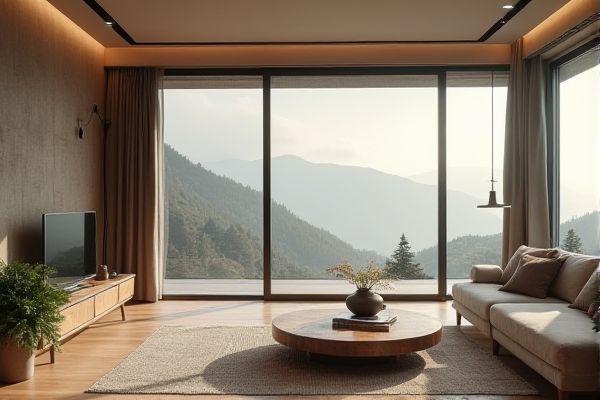
Rolling screens offer flexibility by retracting when not in use, providing unobstructed views and easy storage, while fixed screens remain permanently in place, offering durability and a sleek, streamlined appearance. Discover which option best suits Your needs by exploring the detailed comparison in the rest of the article.
Table of Comparison
| Feature | Rolling Screen | Fixed Screen |
|---|---|---|
| Installation | Easy, retractable design | Permanent, fixed frame |
| Space Efficiency | Saves space when retracted | Always occupies fixed space |
| Durability | Moderate, moving parts wear over time | High, solid frame with no moving parts |
| Maintenance | Requires periodic cleaning and mechanism check | Minimal, occasional cleaning only |
| Cost | Generally higher upfront cost | Lower upfront cost |
| Aesthetics | Modern, sleek when retracted | Classic, visible frame |
| Use Case | Ideal for variable screening needs | Best for consistent, permanent protection |
Introduction to Rolling Screens and Fixed Screens
Rolling screens consist of a mesh or perforated filter mounted on a rotating drum or cylinder that continuously removes debris from water or wastewater. Fixed screens are stationary barriers with a uniform surface area, designed to intercept solids and prevent them from entering treatment systems. Both screen types play crucial roles in preliminary water treatment by efficiently separating large particles based on operational needs and flow characteristics.
Key Differences Between Rolling and Fixed Screens
Rolling screens offer flexibility by allowing the screen to be rolled up or down, providing adjustable coverage and easy storage, whereas fixed screens remain permanently in place, offering consistent protection without the option to retract. You can customize your space with rolling screens for variable light control and ventilation, while fixed screens excel in durability and stability for long-term use. The choice between rolling and fixed screens depends on your need for adaptability versus permanence in screening solutions.
Installation Process: Rolling vs Fixed Screens
Rolling screens offer a flexible installation process that involves mounting a retractable frame or cassette, allowing the screen to be easily rolled up or down as needed. Fixed screens require a permanent installation, typically mounted onto a fixed frame or structure, demanding precise measurements and more labor-intensive setup. The rolling screen's ease of installation and versatility make it ideal for spaces where screen use fluctuates, whereas fixed screens provide a sturdy, always-ready solution for dedicated projection environments.
Space Utilization for Rolling and Fixed Screens
Rolling screens optimize space utilization by retracting into compact housings, allowing walls or windows to remain unobstructed when not in use. Fixed screens occupy permanent areas, limiting versatility and reducing available space for other purposes. The dynamic nature of rolling screens makes them ideal for maximizing space efficiency in both residential and commercial environments.
Durability and Maintenance Comparison
Rolling screens offer enhanced durability through their retractable design, which protects the mesh from environmental damage when not in use, reducing wear and tear compared to fixed screens. Fixed screens, while generally robust, remain exposed to weather elements continuously, leading to higher risks of frame corrosion and mesh deterioration over time. Maintenance for rolling screens is typically lower due to their enclosed housing that limits debris accumulation, whereas fixed screens often require more frequent cleaning and repairs to maintain optimal functionality.
Cost Considerations: Rolling Screen vs Fixed Screen
Rolling screens typically cost more upfront than fixed screens due to their complex mechanisms and materials required for mobility. Fixed screens offer a budget-friendly option with lower installation and maintenance expenses, making them ideal for permanent setups. Your choice should balance initial investment and long-term durability based on usage frequency and location.
Aesthetic Appeal and Design Flexibility
Rolling screens offer superior design flexibility by seamlessly integrating into various architectural styles with their retractable feature, preserving clean lines when not in use. Fixed screens provide a consistent aesthetic appeal through their permanent installation, often enhancing the visual stability and frame continuity of outdoor spaces. Both options cater to different design priorities, where rolling screens emphasize versatility and minimalism, and fixed screens focus on structural presence and enduring style.
Practical Applications and Use Cases
Rolling screens excel in practical applications requiring flexibility, such as outdoor patios, RVs, and temporary window coverings where you can easily retract or adjust the screen based on weather or usage needs. Fixed screens are ideal for permanent installations like residential windows or commercial storefronts, providing consistent insect protection and ventilation without altering the structure. Choosing between rolling and fixed screens depends on your need for adaptability versus durability in your specific use case.
Pros and Cons of Rolling Screens
Rolling screens offer flexibility and space-saving benefits by retracting when not in use, making them ideal for variable weather conditions or temporary privacy. Their installation can be more complex and costly compared to fixed screens, with potential mechanical wear over time affecting durability. You can enjoy customizable control over light and airflow, but may need occasional maintenance to ensure smooth operation.
Pros and Cons of Fixed Screens
Fixed screens offer superior image stability and clarity due to their rigid structure, making them ideal for high-quality home theaters and dedicated viewing rooms. They often provide a sleek and minimalist aesthetic without mechanical parts, ensuring durability and low maintenance over time. However, fixed screens lack portability and versatility, limiting their use to a permanent installation in a single location.
 homyna.com
homyna.com